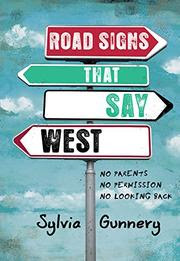| ________________
CM . . .
. Volume XXIII Number 32. . . April 28, 2017
excerpt:
In Sylvia Gunnery’s novel Road Signs That Say West, Hanna persuades her younger sisters, Megan and Claire, to join her on a parent-free road trip across Canada. As each girl deals with her own set of problems-- past, present, and future-- the sisters learn more about themselves, about the lives and problems of others, and about the importance of letting go and moving forward. Between crashing a wedding, hitting a dance club (and an ER), helping a hitchhiker paint a house, and learning to trust their instincts about dangerous people, the journey is not necessarily what they expected. With a cast of interesting yet believable characters, Road Signs That Say West gives a realistic look into the lives and relationships of three very different yet inextricably linked sisters. Road Signs That Say West is a novel that will absolutely find its way to the shelves of the junior high library I run. In a YA world full of fantasy, sci-fi, and dystopian fiction, I have a large number of readers looking for what we call people stories: complex stories about realistic characters and their lives. The sisters in this story are believable and familiar without the author’s resorting to clichés. Hanna is a typical protective eldest sibling, hiding her painful secrets from her younger sisters. She clearly wants to follow her own path but struggles with the thought of leaving them behind. Claire tries to keep up with her older siblings in typical youngest-child fashion. However, she is also dealing with the tragic loss of a close friend, something that neither of her sisters truly understand. Middle sister Megan may be a little bit overlooked and underdeveloped, but isn’t that the way of the middle child? While we eventually get backstories for the other two sisters, there doesn’t seem to be a clear reason for Megan’s constant negativity. The situations that the girls find themselves in make for an interesting but believable road-trip story. While there is nothing boring about their adventure, there is also nothing that jumps off the page as improbable or unlikely. My junior high readers generally like to see some of themselves or their experiences in the novels they read, and this book would certainly accomplish that for many of them. For those buying books for a younger audience, there is some mature content in this novel; it’s done subtly, though, and is always pertinent to the story. Road Signs That Say West reads quickly and cleanly, with simple yet engaging language. It’s broken up into sections; there are smaller passages within the chapters, and 6-8 chapters within each of the three parts. This structure makes the novel manageable for struggling readers without affecting the flow of the story or making it choppy. It’s written entirely in third-person present tense, presumably to make it feel as if the reader is travelling with the girls. Overall, this choice works; one standout example would be in Part Two, Chapter Three, when Claire is lying in bed listening to a rainstorm pass overhead. That said, there were other times when a first-person perspective might have been beneficial. On a personal note, there are few things I enjoy more than seeing my hometown mentioned in works of literature. Gunnery’s novel opens with a fitting quote from Islander Catherine McLellan’s song “Lines on the Road”. A few chapters in, there is a reference to the university in Charlottetown. A reader in Southern Manitoba will recognize the name Pinawa, and one in Saskatchewan might recognize Weyburn. Baddeck, Edmundston, Jasper, and Mount Robson are among the other places named as the girls travel west across Canada. The mentions of various cities and landmarks across the country is a perfect way to draw readers into the story. Highly Recommended. Allison Giggey is the teacher-librarian at an intermediate school in Prince Edward Island.
To comment
on this title or this review, send mail to cm@umanitoba.ca.
Copyright © the Manitoba Library Association. Reproduction for personal
use is permitted only if this copyright notice is maintained. Any
other reproduction is prohibited without permission.
Next Review | Table of Contents For This Issue -April 28, 2017 |
